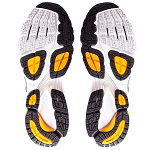 Feet withstand incredible natural forces every day, especially during runs and other vigorous exercise. But unless they’re currently in pain, our feet are often neglected.
Feet withstand incredible natural forces every day, especially during runs and other vigorous exercise. But unless they’re currently in pain, our feet are often neglected.
The problem is most fitness buffs’ main concerns are not protecting their feet, but boosting their endurance or bulking their biceps. However, proper shoes can prevent injuries and chronic pain that distract us from achieving those other goals.
So before the next time you’re in an athletic store, consider these four aspects of shoe selection:
Knowing Your Wear Pattern
If you have some old running shoes, inspect them to learn about your own biomechanics. If your shoes are more worn near the arch, you overpronate your feet. If the outside is worn, you likely underpronate. Those in former category, which is much more common, need very stable shoes with lots of medial support, while those in the latter need more flexible shoes. On the other hand, high arches require added arch support, which may require special insoles or visiting a podiatrist.
Matching Shoe-Type to Activity
The wide array of shoes available is no marketing gimmick. Rather, many shoes are designed only for specific activities. For example, most runners stride with a heel-to-toe strike, so running shoes usually include extra heel padding. Then again, some now advocate a toe first running stride, but this requires shoes with a minimal sole. Meanwhile, traditional cross-trainers provide all-around support and are best for gym workouts, aerobics classes, and short duration cardio.
Finding Your Best Fit
Even the right shoe is nothing with the wrong fit. When looking for any fitness footwear, always try on your usual size, one size up, and one down, and always keep an open mind. Take a minute or two with each to see how your feet really feel in the shoe. Ideally, the feet should not roll to either side when you walk, the fit should be most snug around the middle of the feet, and there should be a little less than one thumb’s width between your toes and the end of the shoe.
Remembering Regular Replacement
Worn out fitness shoes quickly stop providing proper support. A good rule is to replace your regular workout shoes every six to eight months if you exercise at least five times per week and every 12 months if you exercise less regularly. Dedicated runners should replace their shoes based on the distance travelled in them, which is another great reason to keep a running log. A good time to begin considering replacement is after 500 kilometers, or about 100 5k runs!
You can find Karp Fitness on Twitter, LinkedIn & Facebook
Shaun Karp is a certified personal trainer. For further information call his office at 604-420-7800 or visit their web site www.karpfitness.com.
